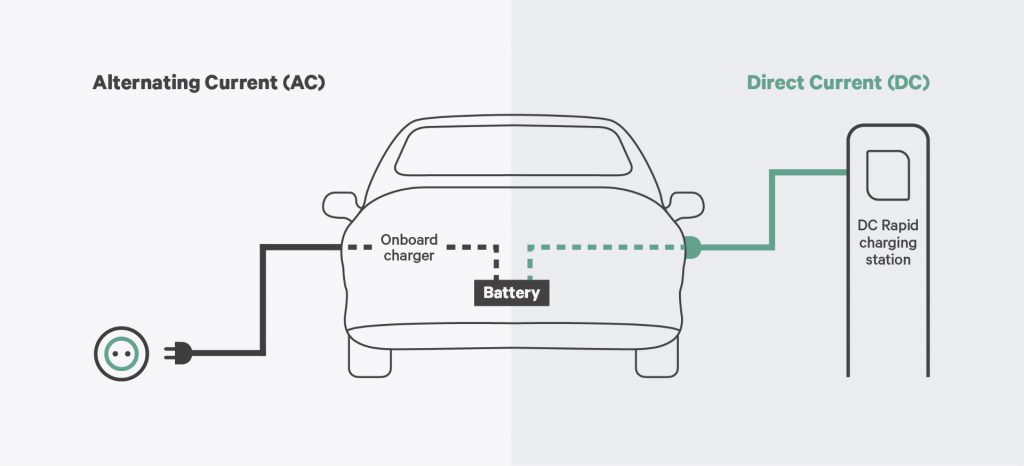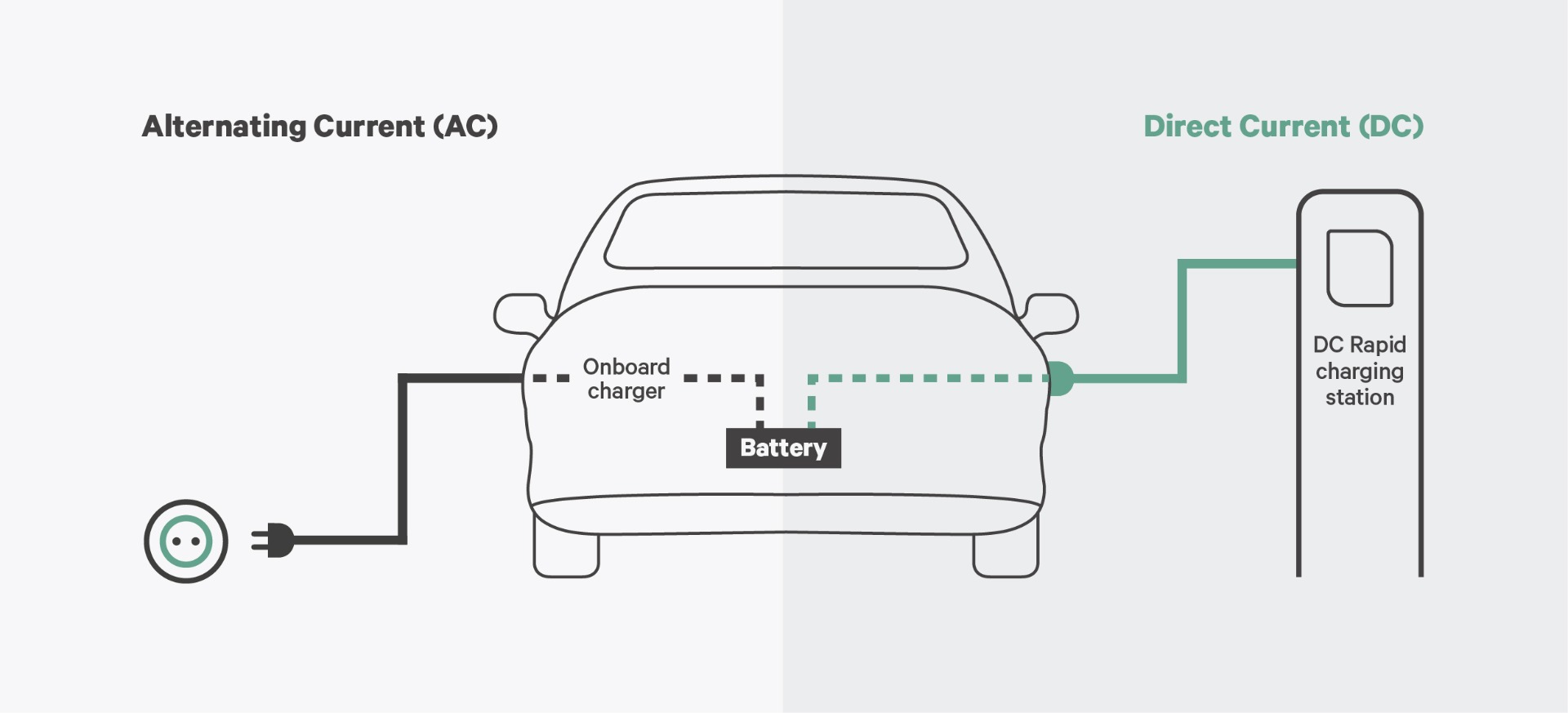We have seen constant improvements in the field of electric vehicles (EVs), and among the various technological advancements, those related to charging are also always evolving. Although on average, the batteries on these green vehicles take about 8 hours to charge from empty to full, the number can range widely, being anywhere from 30 minutes to 12 hours. This depends on the charging speed that your EV allows and its grid capabilities.
There are a number of things you need to learn about electric vehicle charging to properly and efficiently charge your baby, including the standards for different levels of charging, the different types of charging plugs, which plug your car comes with and which public charging stations you can charge your car at.
Contents
Types of EV Charging Plugs & Charging Levels
EV Charging 101: Two Types of “Fuel” – AC and DC
Before we start, it’s essential that you understand the two kinds of electrical power or ‘fuels’ that electric cars consume, since they allow for two types of charging with different charging speed: alternating current (AC) and direct current (DC). While the power coming from the grid is always AC power, batteries like the one in your smartphone or electric vehicle only store power as DC.
This means that your EV as well as most electronic devices have a converter built into the plug for converting AC power from the grid to DC power, which the batteries can store. With EV charging, the difference between AC charging and DC charging is whether the AC power gets converted inside the car or outside.
AC Charging: AC charging is the standard and still currently most common charging method for electric vehicles. All electric vehicles have a built-in converter inside, which is called the onboard charger, to convert power from AC to DC and then feed it into the car’s battery. The conversion happens inside the car with AC charging
DC Charging: Unlike AC charging, the conversion from the grid’s AC power to DC power happens inside the DC charger, thanks to the built-in converter inside the charger itself. This means there is no need for the car’s onboard converter, since the DC charger can convert AC power to DC and directly feed DC power to the car’s battery. DC chargers available at public charging stations make for an exciting breakthrough with much faster charging speed.

Here’s another basic industry knowledge: there are different types of charging plugs for different car makes and models, which allows for different levels of charging (or in other words, how long it takes to fully charge your RV). And in addition to charging your electric vehicle at a public charging station, you can also do this at home, at work or on the go while traveling.
In any case, one thing is absolute essential: you need the right plug. That is, the cable that connects your EV with the public charging station or any electric socket you intend to use has to have the right plug on both ends. In other words, two things have to match: the outlet of your green vehicle and the outlet of the charging station.
In general, there are two major types of standard plugs at public charging stations for alternating current (AC) which allow a charging speed of up to 43 kW (with two other types for charging at home and on the go), and two types of standard plugs for direct current (DC) which allow much fast charging of up to 350 kW. The other special DC plug is the one developed by Tesla and offered exclusively to Tesla EVs, which will be introduced at the end.
The 2 AC Plugs & 2 Charging Levels
At Public Charging Stations
Type 1 plug: The type 1 plug is a single-phase plug which allows for the lowest level of charging power, that is merely up to 7.4 kW (230 V, 32 A).
It is standard for American made electric vehicles and also mainly used in Asian cars. While some European EVs do use this plug, it is not standard here, and thus there are very few public charging stations with this type of plug in Europe.
Type 2 plug: Type 2 plugs are also called triple-phase plugs because they have three additional wires to let more current run through and thus can charge your car faster than the type 1 plug. So naturally, they allow for much higher levels of charging power, depending on the charging power of your car and grid capability. The average charging power at public charging stations is up to 43 kW (400 V, 63 A, AC) , while at home, the highest charging speed is 22 kW.
The triple-phase plug is also called the Mennekes plugs and is standard on electric vehicles made in Europe. That said, most public charging stations outside of Europe these days are equipped with a type 2 socket. Level 2 charging stations are compatible with all pure electric vehicles (BEV, or battery electric vehicles) as well as hybrids (PHEV, or plug-in hybrid electric vehicles). Until now, it remains the standard for commercial charging.
Here’s a real life example to demonstrate how you can charge your EV with a mismatch of outlets. If there’s no mismatch, say you live in Europe and have a European car, you will be using a type-2-to-type-2 charging cable to charge at a public station, that is a cable with type 2 plugs at both ends. In this case, you will get the public station’s standard charging speed of up to 43 kW.
A different scenario is if you own an Asian car. The outlet on your vehicle is a type 1 plug, since this is standard for EVs made in Asia, while the standard plug at a public charging station in Europe is type 2 plug. So you will need a type 2 to type 1 cable to connect the station’s type 2 outlet to your vehicle’s type 1 outlet. The maximum charging speed will be up to 7.4 kW, since your Asian made EV only allows for this power level.
At Home and One The Go
Apart from the above two plugs available at public charging stations, you can also charge your EV at home, at your office or on the go while traveling with domestic sockets in your home or the CEE plugs.
Domestic sockets: With the appropriate fusing, you can plug your EV into a domestic socket to get charging speed of up to 3.7 kW (230 V, 16 A). If you’re plugging into a domestic socket at an unfamiliar place and thus could not check it beforehand, a maximum charging power of only 2.3 kW (230 V, 10 A) is highly recommended to avoid electrical problems.
CEE plug: The CEE plug is available in both the single phase and the triple phase variants:
- A single-phase CEE plug is also called a camping plug and is colour coded blue, with a charging power of up to 3.7 kW (230 V, 16 A)
- A triple-phase CEE plug is colour coded red and is meant for industrial sockets:
- large CEE 32 industrial plugs with a maximum charging speed of up to 22 kW (400 V, 32 A)
- small CEE 16 industrial plugs with a maximum charging speed of up to 11 kW (400 V, 26 A)
There are two different levels of AC charging for electric vehicles with different speeds and voltages.
Level 1 Charging (120-volt AC)
This type of charging, known as Level 1 Charging, is available for virtually any electric vehicle on the planet. All EVs come with a charging cable that allows you to plug into any 120-volt domestic wall socket that you’ll find inside your house. Domestic sockets can also sometimes be found at public charging stations.
The charging cable and plug for charging with an ordinary wall outlet is often supplied by the car manufacturer for emergency charging on the go. The more advanced version of this Level 1 charging is a charging cable with a connector for different CEE industrial sockets for higher charging speeds.
Level 2 Charging (240-volt AC)
Level 2 charging stations are the most common type of commercial public charging stations for EVs. The charging stations installed at public spaces and private businesses are most likely a Level 2 station, like those found at your local department store or gym. They have cables to connect to the standard charging port on your car.
Level 2 charging stations offer a charging speed of multiple times faster than Level 1 charging. Most home and public Level 2 charging stations charge at 240 volts AC.
For any pure-electric vehicle such as the Nissan Leaf, having an at-home charging station for overnight charging is essential. The Level 2 at-home chargers are often available for full-electric cars. You can choose to install one of these Level 2 chargers in your own garage for convenience, but it will require professional installation and wiring. This is generally not a DIY project.
All EVs sold in the United States North America use the same standard J-1772 plug (also known as the J-Plug) for both Level 1 and Level 2 charging stations. That said, for superfast Level 3 Charging, different EV manufacturers use different standards for DC charging.
As mentioned, Tesla developed their own high-speed charging network called Tesla Superchargers, which belongs to Type 3 DC charging. But their EVs also come with an adaptor for the J-1772 standard, so you can conveniently charge your vehicle at normal EV charging stations or conveniently charge it overnight from your own garage. You can also charge from a normal 120-volt electrical outlet.
READ MORE
The 3 DC Plugs and Charging Level
DC Fast Charging (Level 3 Charging)
DC chargers use the built-in converter to directly feed direct current (DC) rather than alternating current (AC) to an EV’s batteries. They are bigger and allow for a faster charging experience. This type of charger usually takes about 20 minutes to charge your battery to 50 percent and takes about 75 minutes to restore it to a full charge.
With DC fast charging, there are three different types of charging plugs:
CHAdeMO
This quick charging system was developed in Japan, and allows for charging capacities up to 100 kW at the appropriate public charging stations. Since it allows for very high charging capacities as well as bidirectional charging, Asian automakers have been manufacturing electric vehicles that are compatible with a CHAdeMO plug. The brands that offer CHAdeMO-compatible electric cars include Nissan, Toyota, Honda, Kia, Mazda, Mitsubishi, Subaru, Peugeot, Tesla (with adaptor), BD Otomotive, and Citroën.
CCS (Combined Charging System, or Combination Plugs)
The CCS plug is the successor of the type 2 plug, with two additional power contacts for enhanced charging speed. It supports both AC and DC charging, with a maximum charging power level of 350 kW. In practice, the realistic number is usually around 170 kW. The automakers that offer EVs using CCS plug include Ford, BMW, Volkswagen, Chevrolet, Mercedes, and Volvo.
Tesla Supercharger
Tesla developed its own network of fast-charging Supercharger stations exclusively for Tesla owners. If you own a Model S, you only need less than 30 minutes to recharge to 80%. Tesla also sells adapters so that you can charge your Tesla EV at CHAdeMO or CCS charging stations.
Tesla Superchargers stations are conveniently installed along popular routes throughout the world, often at high-traffic public places such as fueling stations and large shopping malls, so you can spend time elsewhere shopping or running errands while your vehicle charges. As of early 2021, there are currently over 23,277 Superchargers in over 2,564 stations across North America, Europe, the Middle East, and Asia, or an average of 9 chargers per station.



